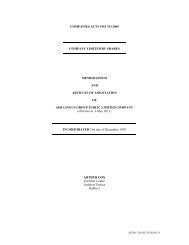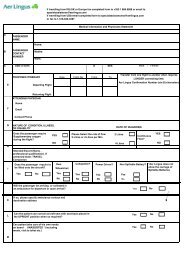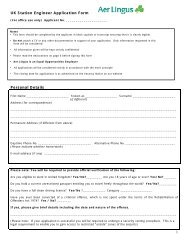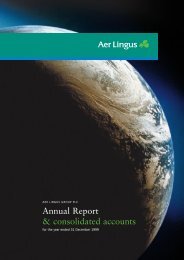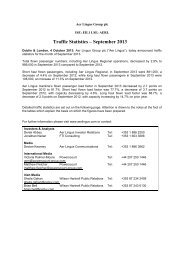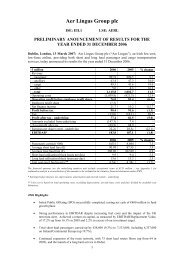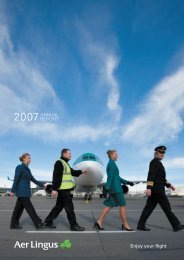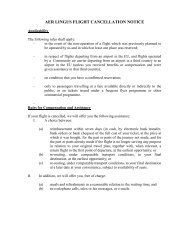annual report 2009 - Aer Lingus
annual report 2009 - Aer Lingus
annual report 2009 - Aer Lingus
You also want an ePaper? Increase the reach of your titles
YUMPU automatically turns print PDFs into web optimized ePapers that Google loves.
Financial Statements <strong>Aer</strong> <strong>Lingus</strong> Group Plc – Annual Report <strong>2009</strong>592 Summary of significant accounting policies [continued]2.11 Derivative financial instruments and hedging activitiesDerivatives are initially recognised at fair value on the date a derivative contract is entered into and are subsequently re-measuredat their fair value. The method of recognising the resulting gain or loss depends on whether the derivative is designated as a hedginginstrument, and if so, the nature of the item being hedged. The Group designates certain derivatives as either:• hedges of the fair value of recognised assets or liabilities or a firm commitment (fair value hedges); or• hedges or a particular risk associated with a recognised assets or liability or a highly probable forecast transaction (cash flow hedge).The Group documents at the inception of the transaction the relationship between hedging instruments and hedged items, as well asits risk management objectives and strategy for undertaking various hedging transactions. The Group also documents its assessment,both at hedge inception and on an ongoing basis, of whether the derivatives that are used in hedging transactions are highly effectivein offsetting changes in fair values or cash flows of hedged items.The fair values of various derivative instruments used for hedging purposes are disclosed in Note 18. Movements on the hedgingreserve in shareholders’ equity are shown in Note 27. The full fair value of a hedging derivative is classified as a non-current asset orliability when the remaining maturity of the hedged item is more than 12 months, and as a current asset or liability when the remainingmaturity of the hedged item is less than 12 months. Trading derivatives are classified as a current asset or liability.(a) Fair value hedgeChanges in the fair value of derivatives that are designated and qualify as fair value hedges are recorded in the income statement,together with any changes in the fair value of the hedged asset or liability that are attributable to the hedged risk. The Group onlyapplies fair value hedge accounting for hedging fixed interest risk on assets and borrowings. The gain or loss relating to the effectiveportion of interest rate swaps hedging fixed rate assets and borrowings is recognised in the income statement within ‘finance income’or ‘finance costs’. The gain or loss relating to the ineffective portion is recognised in the income statement within ‘other gains/losses– net’.If the hedge no longer meets the criteria for hedge accounting, the adjustment to the carrying amount of a hedged item for which theeffective interest method is used is amortised to profit or loss over the period to maturity.(b) Cash flow hedgeCash flow hedges are principally used to hedge the commodity price risk associated with the Group’s forecasted fuel purchases as well ascertain foreign exchange and interest rate exposures. The effective portion of changes in the fair value of derivatives that are designatedand qualify as cash flow hedges is recognised in other comprehensive income. The gain or loss relating to the ineffective portion isrecognised immediately in the income statement within ‘fuel and oil’ in the case of fuel purchases and ‘other gains/losses – net’ in thecase of the foreign exchange derivatives.Amounts accumulated in equity are reclassified to profit or loss in the periods when the hedged item affects profit or loss (for example,when the forecast purchase that is hedged takes place). They are included under the relevant caption in the consolidated incomestatement, i.e. fuel hedges in the ‘fuel and oil’ caption and foreign exchange hedges in the ‘other gains/losses – net’ caption.When a hedging instrument expires or is sold, or when a hedge no longer meets the criteria for hedge accounting, any cumulative gainor loss existing in equity at that time remains in equity and is recognised when the forecast transaction is ultimately recognised in theincome statement. When a forecast transaction is no longer expected to occur, the cumulative gain or loss that was <strong>report</strong>ed in equityis immediately transferred to the income statement.



